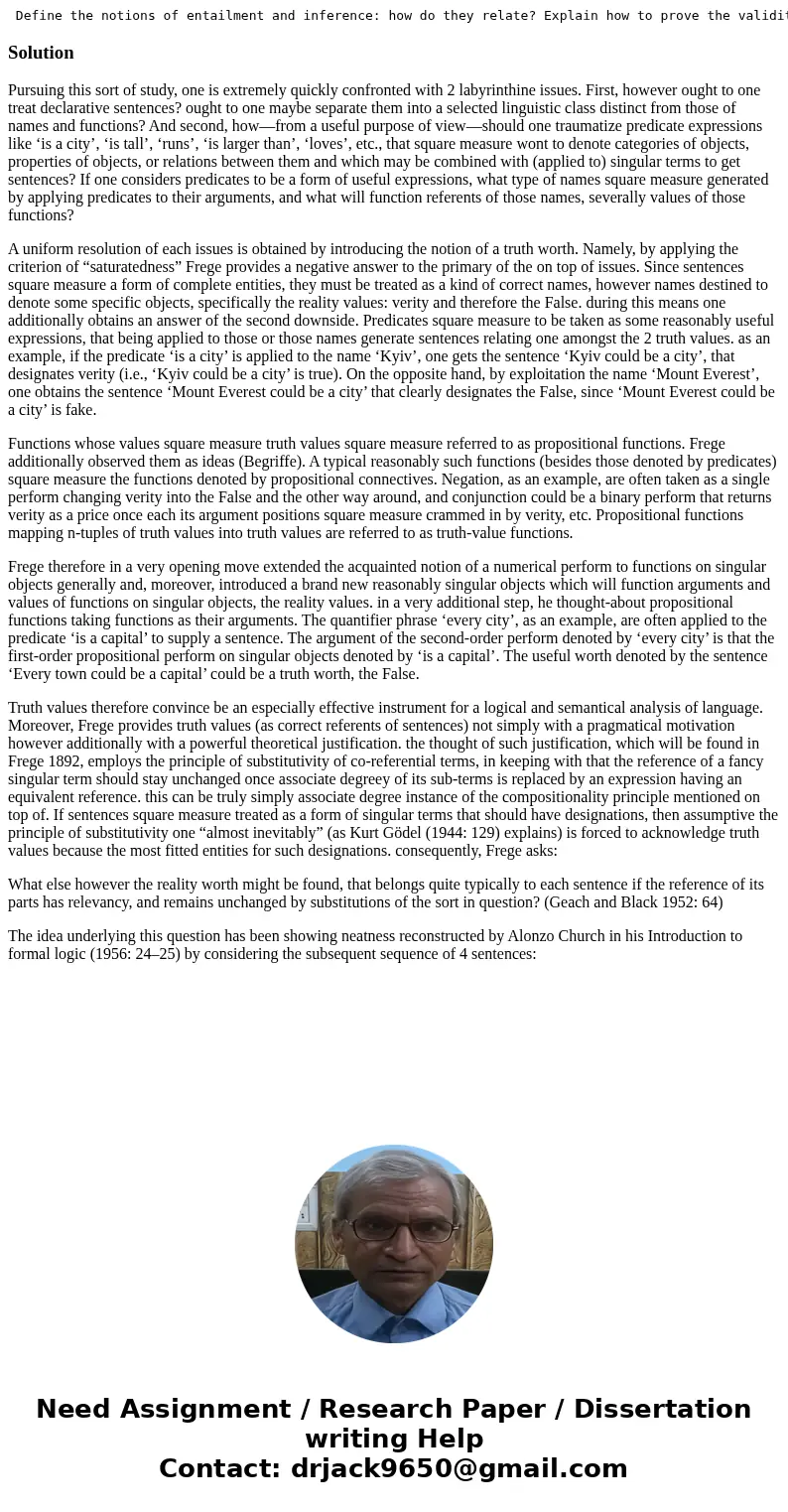Define the notions of entailment and inference how do they r
Define the notions of entailment and inference: how do they relate? Explain how to prove the validity of a PL sentence. Give an example. What is the difference between a model and an interpretation?
Solution
Pursuing this sort of study, one is extremely quickly confronted with 2 labyrinthine issues. First, however ought to one treat declarative sentences? ought to one maybe separate them into a selected linguistic class distinct from those of names and functions? And second, how—from a useful purpose of view—should one traumatize predicate expressions like ‘is a city’, ‘is tall’, ‘runs’, ‘is larger than’, ‘loves’, etc., that square measure wont to denote categories of objects, properties of objects, or relations between them and which may be combined with (applied to) singular terms to get sentences? If one considers predicates to be a form of useful expressions, what type of names square measure generated by applying predicates to their arguments, and what will function referents of those names, severally values of those functions?
A uniform resolution of each issues is obtained by introducing the notion of a truth worth. Namely, by applying the criterion of “saturatedness” Frege provides a negative answer to the primary of the on top of issues. Since sentences square measure a form of complete entities, they must be treated as a kind of correct names, however names destined to denote some specific objects, specifically the reality values: verity and therefore the False. during this means one additionally obtains an answer of the second downside. Predicates square measure to be taken as some reasonably useful expressions, that being applied to those or those names generate sentences relating one amongst the 2 truth values. as an example, if the predicate ‘is a city’ is applied to the name ‘Kyiv’, one gets the sentence ‘Kyiv could be a city’, that designates verity (i.e., ‘Kyiv could be a city’ is true). On the opposite hand, by exploitation the name ‘Mount Everest’, one obtains the sentence ‘Mount Everest could be a city’ that clearly designates the False, since ‘Mount Everest could be a city’ is fake.
Functions whose values square measure truth values square measure referred to as propositional functions. Frege additionally observed them as ideas (Begriffe). A typical reasonably such functions (besides those denoted by predicates) square measure the functions denoted by propositional connectives. Negation, as an example, are often taken as a single perform changing verity into the False and the other way around, and conjunction could be a binary perform that returns verity as a price once each its argument positions square measure crammed in by verity, etc. Propositional functions mapping n-tuples of truth values into truth values are referred to as truth-value functions.
Frege therefore in a very opening move extended the acquainted notion of a numerical perform to functions on singular objects generally and, moreover, introduced a brand new reasonably singular objects which will function arguments and values of functions on singular objects, the reality values. in a very additional step, he thought-about propositional functions taking functions as their arguments. The quantifier phrase ‘every city’, as an example, are often applied to the predicate ‘is a capital’ to supply a sentence. The argument of the second-order perform denoted by ‘every city’ is that the first-order propositional perform on singular objects denoted by ‘is a capital’. The useful worth denoted by the sentence ‘Every town could be a capital’ could be a truth worth, the False.
Truth values therefore convince be an especially effective instrument for a logical and semantical analysis of language. Moreover, Frege provides truth values (as correct referents of sentences) not simply with a pragmatical motivation however additionally with a powerful theoretical justification. the thought of such justification, which will be found in Frege 1892, employs the principle of substitutivity of co-referential terms, in keeping with that the reference of a fancy singular term should stay unchanged once associate degreey of its sub-terms is replaced by an expression having an equivalent reference. this can be truly simply associate degree instance of the compositionality principle mentioned on top of. If sentences square measure treated as a form of singular terms that should have designations, then assumptive the principle of substitutivity one “almost inevitably” (as Kurt Gödel (1944: 129) explains) is forced to acknowledge truth values because the most fitted entities for such designations. consequently, Frege asks:
What else however the reality worth might be found, that belongs quite typically to each sentence if the reference of its parts has relevancy, and remains unchanged by substitutions of the sort in question? (Geach and Black 1952: 64)
The idea underlying this question has been showing neatness reconstructed by Alonzo Church in his Introduction to formal logic (1956: 24–25) by considering the subsequent sequence of 4 sentences:

 Homework Sourse
Homework Sourse